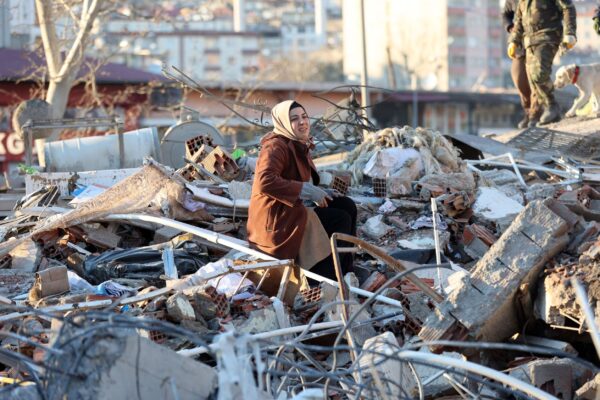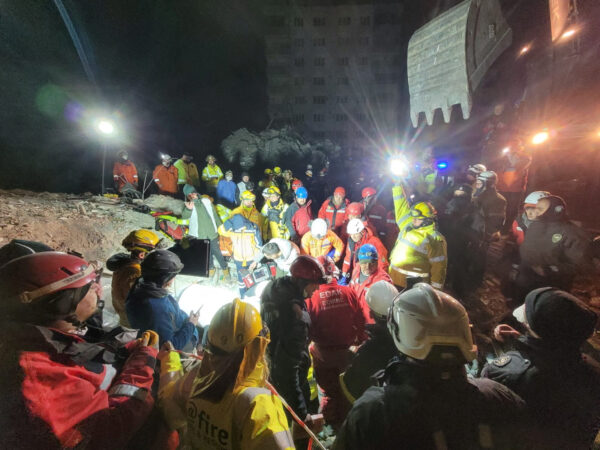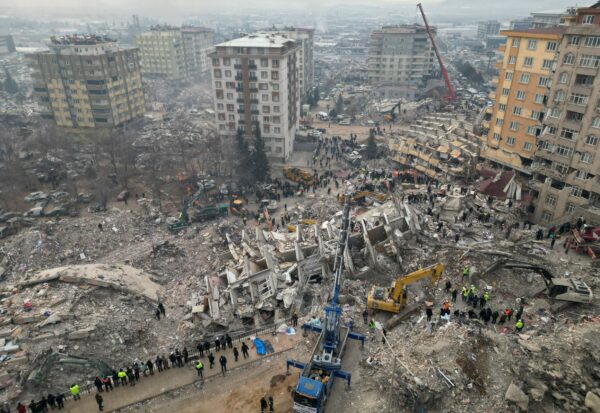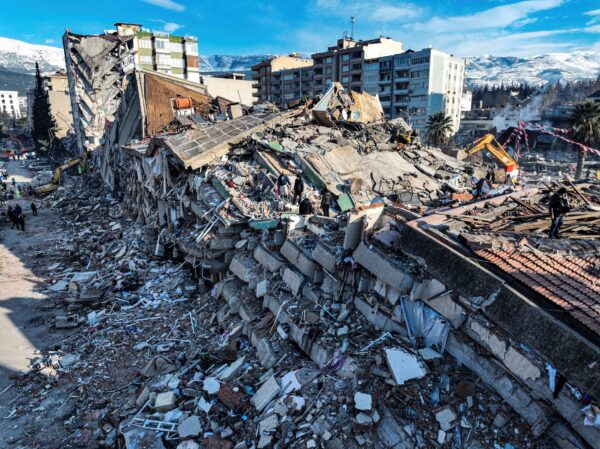

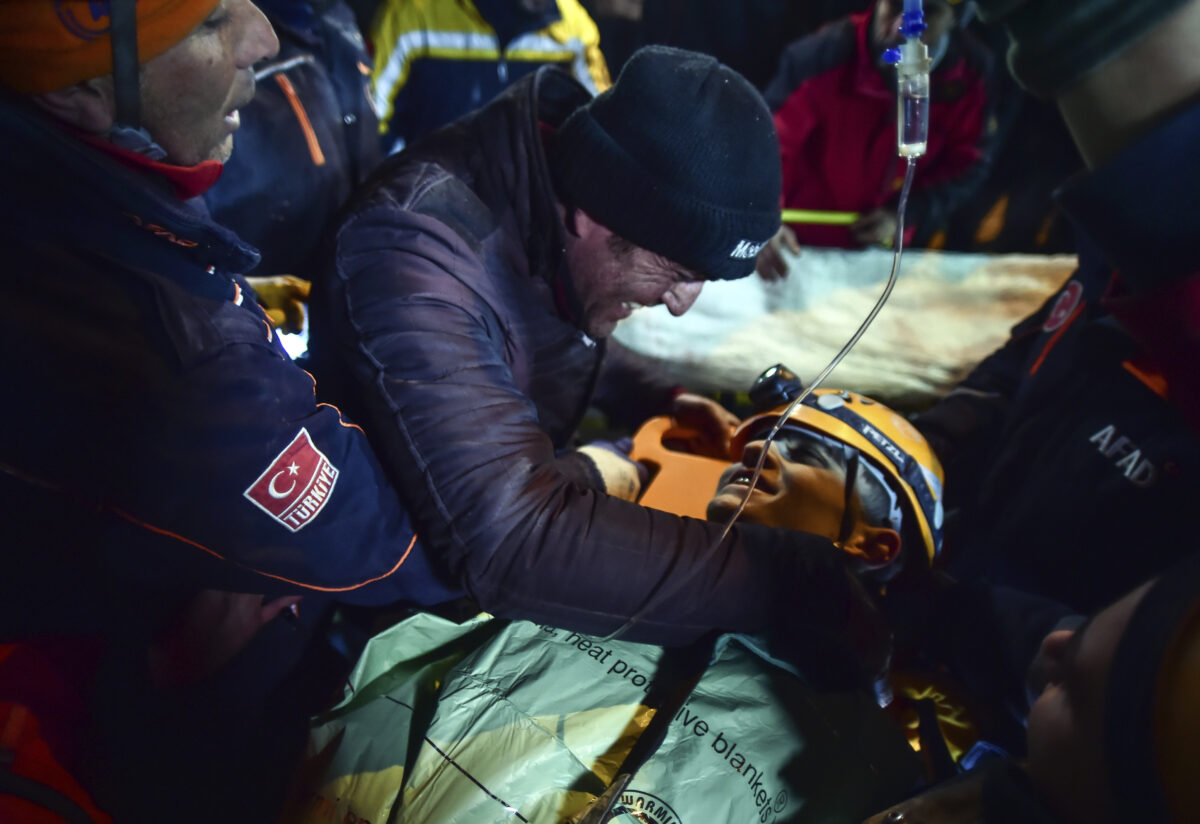
KAHRAMANMARAS, Turkey—Five days after Kahramanmaras became the epicenter of back-to-back earthquakes measuring 7.7 and 7.6 on the Richter scale, the scope of destruction in the southern Turkish province almost defies belief.
In central Kahramanmaras, entire neighborhoods have been flattened beyond recognition. Dazed survivors congregate near mountains of rubble that were once multi-story buildings, anxiously awaiting news of missing friends and family members.
“My daughter-in-law and grandchild were both killed in the first quake,” an elderly woman, who declined to give her name, told The Epoch Times. “Now I’m waiting for them to find my brother and nephew.”
Pointing forlornly at a towering heap of wreckage, she asked: “How could anyone survive that?”
Along with Kahramanmaras, the twin quakes caused varying degrees of devastation in nine other provinces of southern Turkey, where a three-month state of emergency has since been imposed.
On the evening of Feb. 11, Turkey’s official death toll stood at 24,617 with another 80,000 reportedly injured. Both numbers—especially the first—are expected to rise even further as more bodies are pulled from the rubble. Syria’s official death toll stood at 3,553, taking to total number of deaths from the disaster to 28,170.
Speaking to residents of central Kahramanmaras, virtually everyone has a harrowing story to tell.
“I lost my mother, father, sister, and brother-in-law, along with their three children, when their building collapsed,” Serife Durna, a local resident and mother of two, told The Epoch Times.
“The only one to survive was my one-year-niece,” she said, tearfully showing the little girl’s picture on her mobile phone. “For us, she’s like a miracle.”
Durna’s building is still standing, but she’s unable to stay there amid fears of more tremors. She is currently staying at Kahramanmaras University, where she works as a lecturer, along with hundreds of others who have been rendered homeless.
Standing at her side, Durna’s brother, who rushed from capital Ankara after the quakes, said: “The scope of destruction is unbelievable. Every family here is coping with its own tragedy.”
According to Turkey’s Environment Ministry, more than 7,585 buildings have collapsed entirely due to the initial quakes, along with some 2,000 aftershocks that continue to shake the region.
On Feb. 9, the southern provinces of Gaziantep and Elazig were both rattled again by a 4.4-magnitude tremor. The following day, a 4.2-magnitude aftershock reportedly shook Kahramanmaras, bringing down another three buildings.
But since the city’s tall buildings have long been abandoned, no one was hurt.
An overwhelming sense of grief, which hangs over the city like a funeral pall, is occasionally punctuated by joyous tidings. On the evening of Feb. 10, the Turkish authorities announced that 67 people in quake-affected areas had been rescued over the previous 24 hours.
In Kahramanmaras, too, where the devastation is worst, survivors are still being found, thanks largely to the tireless efforts of rescue workers. On Feb. 9, a one-year-old baby was pulled out alive from beneath the debris of a fallen building.
The following day, there was more good news, despite the passage of four days since the quakes and nighttime temperatures that frequently fall below freezing.
“A short time ago, we heard someone shouting for help from under the rubble,” the head of a rescue team from Turkey’s Hayrat aid foundation told The Epoch Times.
“She was trapped on the third floor of a collapsed building, with one of her legs stuck under a fallen column,” the rescue worker, who did not give his name, said.
“We managed to pull her out after lifting the column,” he added. “Her name is Ayse; she’s 18 years old. She’s now in stable condition and receiving treatment.”
Since the twin quakes struck five days ago, volunteers from all over the world have flown into Turkey to assist ongoing search-and-rescue efforts.
A 104-member team from El Salvador, which arrived in the country on Feb. 8, is now working around the clock in 10-hour shifts in the Sazibey district of Kahramanmaras.
Until now, the team has only found dead bodies among the wreckage. But they plan to stay in the country for another week–at least–and still entertain hopes of finding survivors.
“Our sniffer dogs and thermal cameras indicate that there are still people alive in there,” team member Wilson Ernesto, 50, told The Epoch Times.
Ernesto, who works as a firefighter in El Salvador, also assisted rescue efforts in Haiti, which was devastated by a 7-magnitude quake in 2010 that killed an estimated 220,000 people.
“Our country suffers frequent earthquakes, so we feel empathy for others when it happens to them,” he said. “That’s why we came.”
Other volunteer search-and-rescue experts currently working in Kahramanmaras have come from as far afield as France, South Korea, Romania, Israel, and Australia.
The mounting death toll has now surpassed that of a 7.6-magnitude earthquake that struck northwestern Turkey in 1999, leaving more than 17,000 dead. Turkish President Recep Tayyip Erdogan has described this week’s twin quakes as the country’s “biggest natural disaster in a century.”
Throughout history, the geographical area that is now modern-day Turkey–which sits astride two major fault lines–has been prone to seismic activity. In 1939, more than 32,000 people were killed when a massive earthquake struck the country’s central Erzincan Province.
The Feb. 6 quakes were felt as far away as Cyprus, Lebanon, and Egypt. But the only other country to suffer comparable damage was Syria, which shares a 565-mile border with Turkey.
According to Syrian sources, more than 3,100 people were killed by the quakes in the country’s northern Idlib, Aleppo, Hama, Latakia, and Raqqa provinces.
In the meantime, survivors in Turkey’s Kahramanmaras Province struggle to come to terms with their grief.
“After suffering such loss, I thought I was going to lose my mind,” Durna said. “But somehow we’ll find the strength to bear all this pain.”
“We trust in Allah. I’ve begun to feel peace,” she added. “I know I did my best for my family. Now I have nothing more to lose.”

